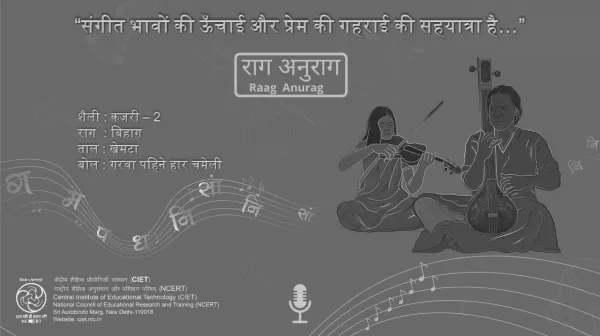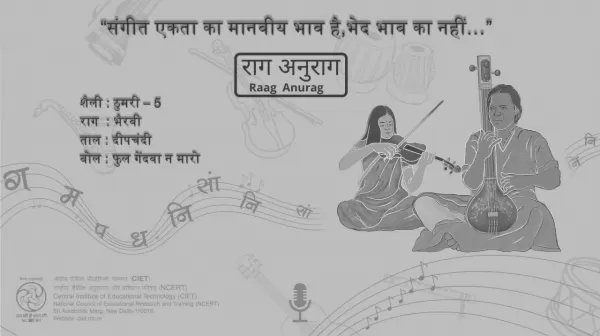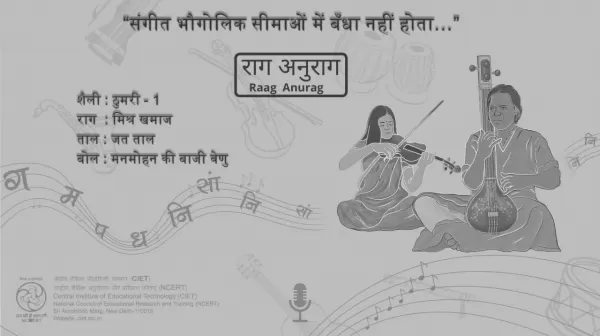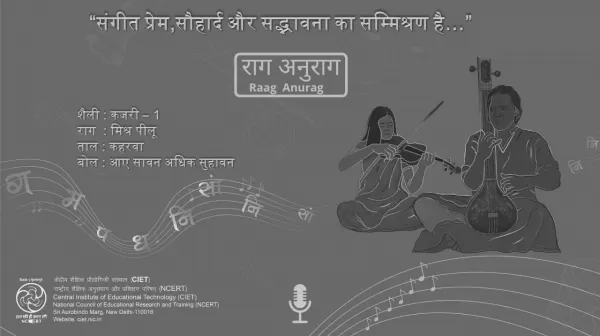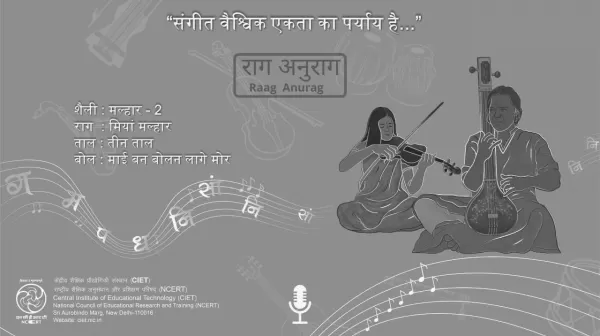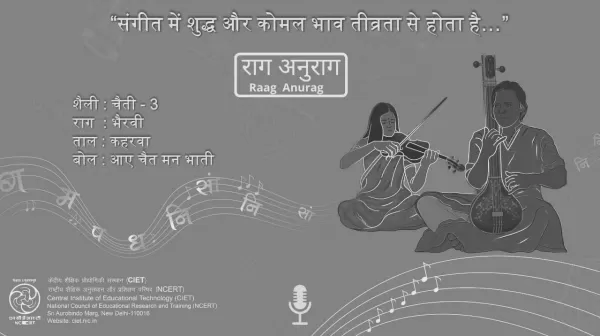Chaiti -1 Rag Des "Jhukvan Pawan Jhakore"
Chaiti is semi classical style of Hindustani music. It has derived from the folk music of the Indian state of Uttar Pradesh and based on chaitra month i.e. the mid-March of English calendar. Semi-classical “Bandish” (Determined melody structure) are sung in it. Love, beauty of nature and the Holi festival (the Indian festival of colors) are the prominent themes of Chaiti. Chaitra month is also considered as the birth month of Shri Rama and thus, the scriptural descriptions of the childhood of Shri Rama are included in the singing structure of Chaiti. In melody ascension of Rag Des, Gandhar and Dhaiwat i.e. (Me and Ti notes are restricted whereas Nishad (Both Ti notes are applied, remain all notes (swaras) are tonic. The category of Rag Des is “Audhav” and it is incepted from Khamaj family. It’s Wadi swara (Rishabh i.e. Re note and Samvadi swara is Pancham i.e. Soh note. Wadi is the primary note of any rag whereas usually the 5th note is Samvadi. The singing time of this Rag is the 2nd watch of the night. The fundamental genre of Chaiti is changed in western style of presentation though the basic rendering of Rag Des remains the same, with having freedom of divergence of different ragas. Music is not confined to the geographical boundaries. Indian Ragas can be played not only in Indian musical instruments but in western musical instruments as well. Indian music and ragas are being played globally in all other instruments of many cultures and countries. Indian music is being propagated all over the world and liked so much by different world communities. Moreover, nowadays a revolutionary flavor of music has emerged called “Fusion music” a mix of traditional Indian and western musical instruments. Glossary of Indian-Western Music Sargam- Sa Re Ga Ma Pa Dha Ni (Saptak) Notation - Doh Re Mi Fa Soh La Ti Doh (Octave) {In Hindustani music there are 7 notes shown called Saptak i.e. 7} {In Western music there are 8 notes shown thus called Octave i.e. 8 } Aaroh- Ascension (Lower to higher notes) Avroh- Dissention (Higher to lower notes) Pakad – Insignia/ Recognition/Restricted melody grip Bandish/Rachna- Determined melody structure Shuddh Swara- Natural Note, Tonic Komal Swara - Flat (b)- One semitone lower in frequency Teevra- Sharp (#)- 1 semitone higher in frequency Taal- Beat Shaili- Style/Genre Audav- Pentatonic Scale with 5 pitches or notes per octave Shadav- Hexatonic scale with 6 pitches or notes per octave Sampurna- Septatonic scale with 7 notes or pitches per octave Thhat- Family Wadi is the primary note of any rag whereas usually the 5th note is Samvadi. Chord- Notes - Sa, Ga, Pa, Sa- (Doh, Me, Soh, Doh) All Natural notes=Major. If Ga (Me) is one semitone flat (Komal) it is Minor chord. Example- If any note is to be shown as Komal (flat), it is denoted as the sign of small b If any note is to be shown as Teevra (Sharp ), it is denoted as the sign # The rendering of any Rag may be in Major or in Minor chord regardless of any scale. Major chord means= All notes are natural; Example- Formation of Major chord- Sa, Ga, Pa, Sa {naturel} Minor means=One or more than one notes are either flat or sharp for one semitone. Formation of Minor chord= Sa(Natural). Re (Sharp or Teevra), Ga (Natural), Pa (Natural)
Playlist
Category
- चैती
चैती उत्तर प्रदेश का, चैत माह पर केंद्रित लोक-गीत है। इसे अर्ध-शास्त्रीय गीत विधाओं में भी सम्मिलित किया जाता है तथा उपशास्त्रीय बंदिशें गाई जाती हैं। चैत्र के महीने में गाए जाने वाले इस राग का विषय प्रेम, प्रकृति और होली रहते है। चैत श्री राम के जन्म का भी मास है इसलिए इस गीत की हर पंक्ति के बाद अक्सर रामा यह शब्द लगाते हैं। संगीत की अनेक महफिलों केवल चैती, टप्पा और दादरा ही गाए जाते है। ये अक्सर राग वसंत या मिश्र वसंत में निबद्ध होते हैं। चैती, ठुमरी, दादरा, कजरी इत्यादि का गढ़ पूर्वी उत्तर प्रदेश तथा मुख्यरूप से वाराणसी है। पहले केवल इसी को समर्पित संगीत समारोह हुआ करते थे जिसे चैता उत्सव कहा जाता था। आज यह संस्कृति लुप्त हो रही है, फिर भी चैती की लोकप्रियता संगीत प्रेमियों में बनी हुई है। बारह मासे में चैत का महीना गीत संगीत के मास के रूप में चित्रित किया गया है।
उदाहरण
चैती
चढ़त चइत चित लागे ना रामा/ बाबा के भवनवा/ बीर बमनवा सगुन बिचारो/ कब होइहैं पिया से मिलनवा हो रामा/ चढ़ल चइत चित लागे ना रामा
- 24 views

